Volume 30, Number 12—December 2024
Dispatch
Ehrlichia canis in Human and Tick, Italy, 2023
Figure

Figure. Maximum-likelihood phylogenetic tree of Ehrlichia canis 16S rRNA sequences detected in a patient’s blood and in a Haemaphysalis punctata tick removed from the patient in Italy, 2023. Boldface indicates sequences amplified in the study area. The tree was inferred including 12 partial sequences (281 bp) under the maximum-likelihood method based on the general time reversible model (10) and a discrete gamma distribution was used to model evolutionary rate differences among sites (5 categories) (+G, parameter = 0.3727). The percentage of trees in which the associated taxa clustered together is shown next to the branches. A consensus sequence of Rickettsia raoultii (MT509815) in a human from Russia was used as outgroup. The tree with the highest log likelihood (−559.69) is shown, obtained from 1,000 bootstrap replications with MEGA X software (11). Scale bar indicates nucleotide substitutions per site.
References
- Mylonakis ME, Harrus S, Breitschwerdt EB. An update on the treatment of canine monocytic ehrlichiosis (Ehrlichia canis). Vet J. 2019;246:45–53. DOIPubMedGoogle Scholar
- Maeda K, Markowitz N, Hawley RC, Ristic M, Cox D, McDade JE. Human infection with Ehrlichia canis, a leukocytic rickettsia. N Engl J Med. 1987;316:853–6. DOIPubMedGoogle Scholar
- Ewing SA, Johnson EM, Kocan KM. Human infection with Ehrlichia canis. N Engl J Med. 1987;317:899–900. DOIPubMedGoogle Scholar
- Perez M, Rikihisa Y, Wen B. Ehrlichia canis-like agent isolated from a man in Venezuela: antigenic and genetic characterization. J Clin Microbiol. 1996;34:2133–9. DOIPubMedGoogle Scholar
- Perez M, Bodor M, Zhang C, Xiong Q, Rikihisa Y. Human infection with Ehrlichia canis accompanied by clinical signs in Venezuela. Ann N Y Acad Sci. 2006;1078:110–7. DOIPubMedGoogle Scholar
- Bouza-Mora L, Dolz G, Solórzano-Morales A, Romero-Zuñiga JJ, Salazar-Sánchez L, Labruna MB, et al. Novel genotype of Ehrlichia canis detected in samples of human blood bank donors in Costa Rica. Ticks Tick Borne Dis. 2017;8:36–40. DOIPubMedGoogle Scholar
- Otranto D, Dantas-Torres F, Giannelli A, Latrofa MS, Cascio A, Cazzin S, et al. Ticks infesting humans in Italy and associated pathogens. Parasit Vectors. 2014;7:328. DOIPubMedGoogle Scholar
- Sgroi G, Iatta R, Lia RP, D’Alessio N, Manoj RRS, Veneziano V, et al. Spotted fever group rickettsiae in Dermacentor marginatus from wild boars in Italy. Transbound Emerg Dis. 2021;68:2111–20. DOIPubMedGoogle Scholar
- Cicculli V, Masse S, Capai L, de Lamballerie X, Charrel R, Falchi A. First detection of Ehrlichia minasensis in Hyalomma marginatum ticks collected from cattle in Corsica, France. Vet Med Sci. 2019;5:243–8. DOIPubMedGoogle Scholar
- Nei M, Kumar S. Molecular evolution and phylogenetics. New York: Oxford University Press; 2000.
- Kumar S, Stecher G, Li M, Knyaz C, Tamura K. MEGA X: Molecular Evolutionary Genetics Analysis across computing platforms. Mol Biol Evol. 2018;35:1547–9. DOIPubMedGoogle Scholar
- Dantas-Torres F, Otranto D. Species diversity and abundance of ticks in three habitats in southern Italy. Ticks Tick Borne Dis. 2013;4:251–5. DOIPubMedGoogle Scholar
- Chisu V, Foxi C, Mannu R, Satta G, Masala G. A five-year survey of tick species and identification of tick-borne bacteria in Sardinia, Italy. Ticks Tick Borne Dis. 2018;9:678–81. DOIPubMedGoogle Scholar
- Bezerra-Santos MA, Nguyen VL, Iatta R, Manoj RRS, Latrofa MS, Hodžić A, et al. Genetic variability of Ehrlichia canis TRP36 in ticks, dogs, and red foxes from Eurasia. Vet Microbiol. 2021;255:
109037 . DOIPubMedGoogle Scholar - Centers for Disease Control and Prevention. Tickborne diseases of the US: a reference manual for health care providers, 6th edition. Colorado (CO); The Centers; 2022.